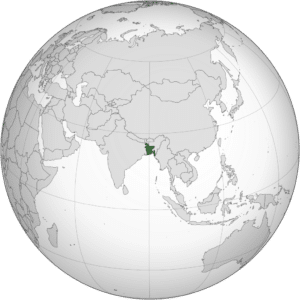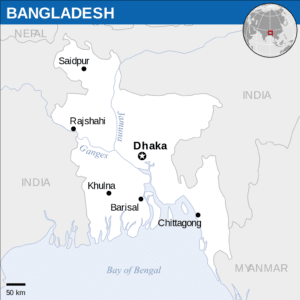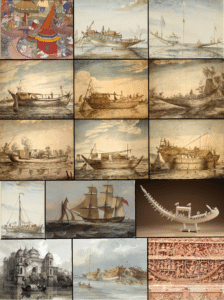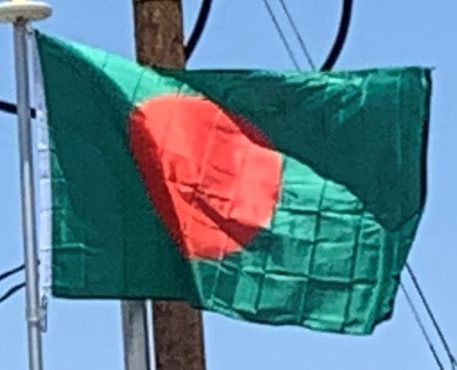Introduction:
Bangladesh, officially the People’s Republic of Bangladesh, is a sovereign country in South Asia. It shares land borders with India and Myanmar. The country’s maritime territory in the Bay of Bengal is roughly equal to the size of its land area. Bangladesh is the world’s eighth most populous country as well one of its most densely-populated, to the exclusion of small island nations and city-states. Dhaka is its capital and largest city, followed by Chittagong, which has the country’s largest port.

Bangladesh forms the largest and eastern part of the Bengal region. The country’s geography is dominated by the Bengal delta with many rivers; while hilly and mountainous areas make up the north-east and south-east. The country also has one of the longest beaches and the largest mangrove forest in the world. The endangered Bengal tiger is a national symbol. Bangladeshis include people from a range of ethnic groups and religions. Bengalis, who speak the official Bengali language, make up 98% of the population. The politically dominant Bengali Muslims make the nation the world’s third largest Muslim-majority country. Constitutionally a secular country, Bangladesh guarantees freedom of religion among other democratic rights.

It is one of the emerging and growth-leading economies of the world. It is also listed among the Next Eleven countries, it has one of the fastest real GDP growth rates. It is also one of the fastest growing middle-income countries in the world. In the field of human development, Bangladesh has progressed ahead of its regional neighbors in life expectancy, maternal and child health, and gender equality. The country continues to face challenging problems, including poverty, corruption, terrorism, illiteracy, and inadequate public healthcare. Bangladesh is a member of the UN, WTO, IMF, the World Bank, ADB, OIC, IDB, SAARC, BIMSTEC and the IMCTC. Bangladesh is also a leading contributor of United Nations peacekeeping forces.
Etymology:
The etymology of Bangladesh (Country of Bengal) can be traced to the early 20th century, when Bengali patriotic songs, such as Namo Namo Namo Bangladesh Momo by Kazi Nazrul Islam and Aaji Bangladesher Hridoy by Rabindranath Tagore, used the term. The term Bangladesh was often written as two words, Bangla Desh, in the past. Starting in the 1950s, Bengali nationalists used the term in political rallies in East Pakistan. The term Bangla is a major name for both the Bengal region and the Bengali language. The earliest known usage of the term is the Nesari plate in 805 AD. The term Vangaladesa is found in 11th-century South Indian records.

The term gained official status during the Sultanate of Bengal in the 14th century. Shamsuddin Ilyas Shah proclaimed himself as the first “Shah of Bangala” in 1342. The word Bangla became the most common name for the region during the Islamic period. The Portuguese referred to the region as Bengala in the 16th century.
The origins of the term Bangla are unclear, with theories pointing to a Bronze Age proto-Dravidian tribe, the Austric word “Bonga” (Sun god), and the Iron Age Vanga Kingdom. The Indo-Aryan suffix Desh is derived from the Sanskrit word deśha, which means “land” or “country”. Hence, the name Bangladesh means “Land of Bengal” or “Country of Bengal”.
History:
Early and Medieval Periods:
Stone Age tools found in Bangladesh indicate human habitation for over 20,000 years, and remnants of Copper Age settlements date back 4,000 years. Ancient Bengal was settled by Austroasiatics, Tibeto-Burmans, Dravidians and Indo-Aryans in consecutive waves of migration. Archaeological evidence confirms that by the second millennium BCE, rice-cultivating communities inhabited the region. By the 11th century people lived in systemically-aligned housing, buried their dead, and manufactured copper ornaments and black and red pottery. The Ganges, Brahmaputra and Meghna rivers were natural arteries for communication and transportation, and estuaries on the Bay of Bengal permitted maritime trade. The early Iron Age saw the development of metal weaponry, coinage, agriculture and irrigation. Major urban settlements formed during the late Iron Age, in the mid-first millennium BCE, when the Northern Black Polished Ware culture developed. In 1879, Alexander Cunningham identified Mahasthangarh as the capital of the Pundra Kingdom mentioned in the Rigveda. The oldest inscription in Bangladesh was found in Mahasthangarh and dates from the 3rd century BCE. It is written in the Brahmi script.
